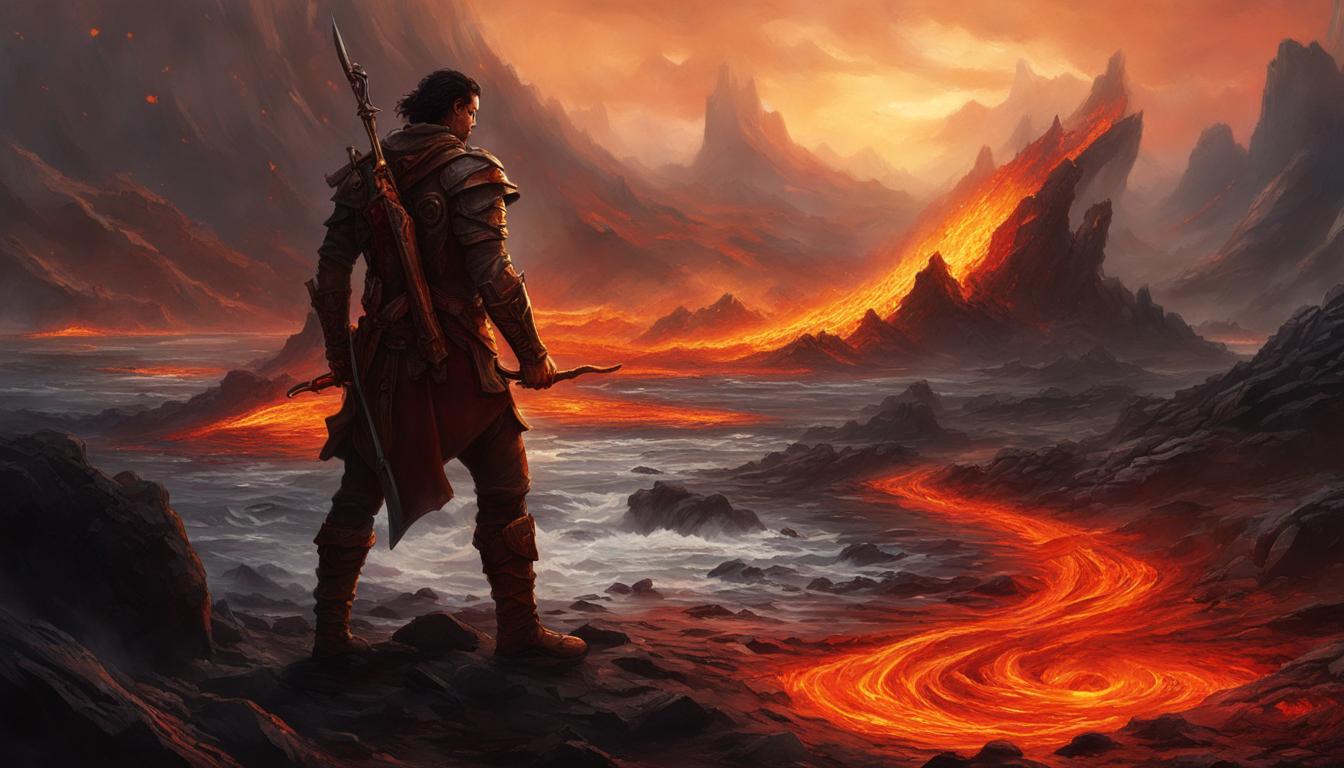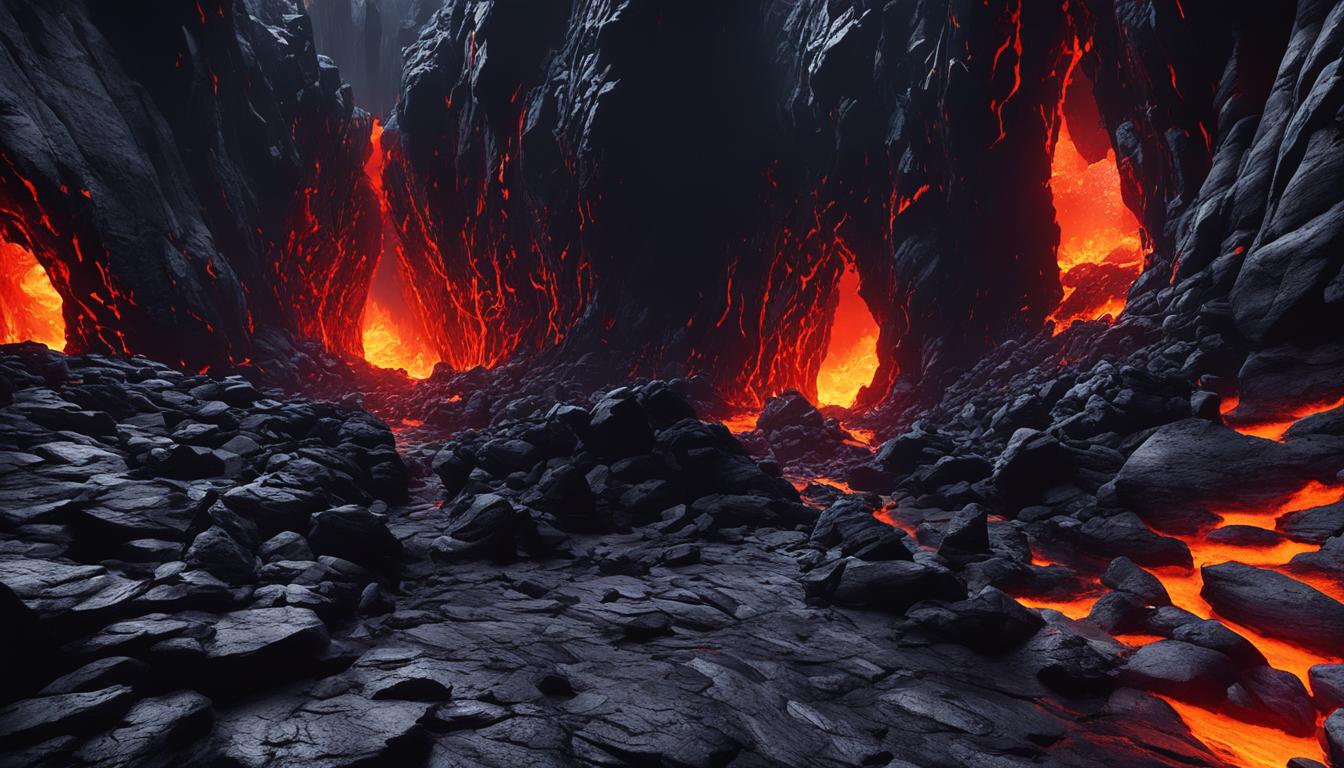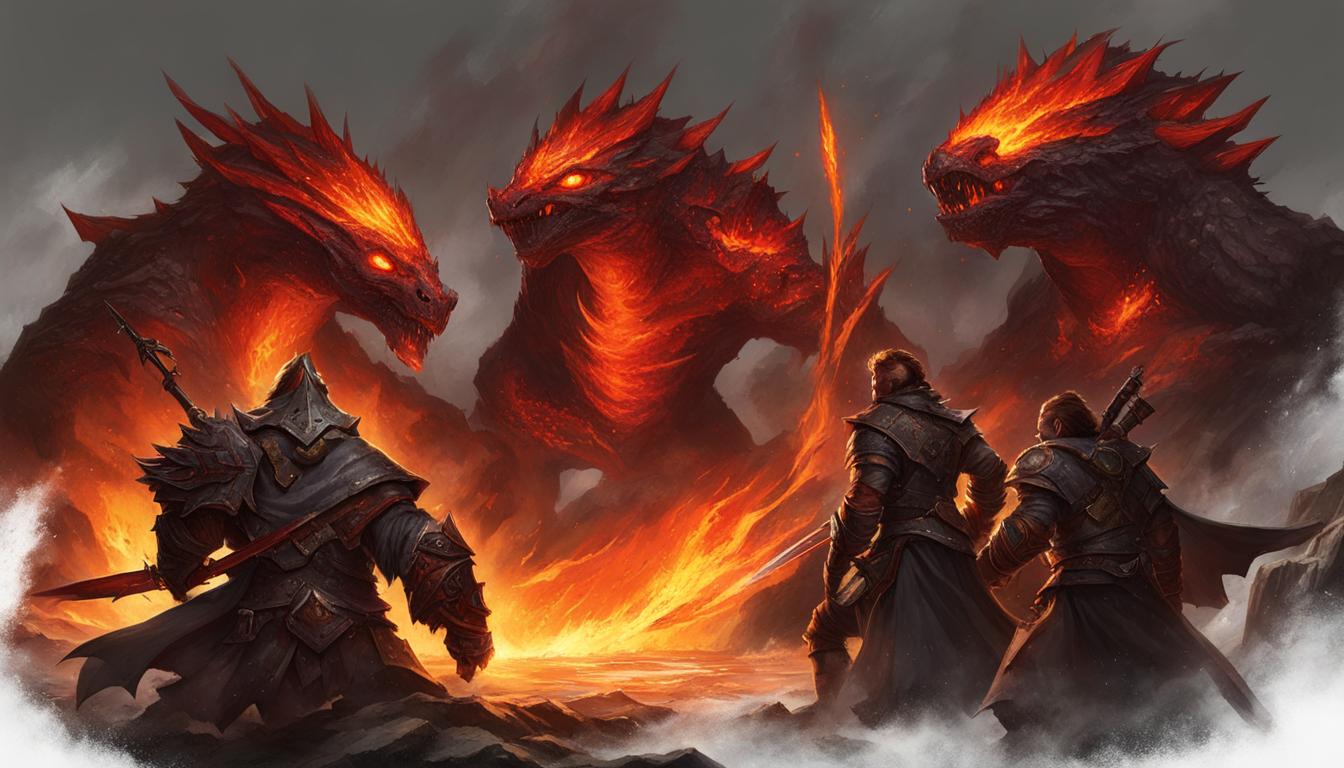Surviving DnD Lava Damage: Tips & Mechanics
Hey there, fellow adventurers! Are you ready to face the fiery dangers of the D&D world? One peril that lurks beneath our feet is the treacherous lava. In this guide, I’ll walk you through some essential tips and mechanics to help you survive and thrive when facing the scorching lava in your D&D campaigns.

Key Takeaways:
- Understanding the official D&D rules for lava damage is crucial in navigating encounters.
- Avoiding direct contact with lava should be your priority to minimize the risk of taking damage.
- Spells like Fire Shield and Levitate can provide valuable protection against the hazardous effects of lava.
- Consider incorporating realistic elements, such as lava density and motion, to make encounters more immersive and challenging.
- Explore creatures with a natural affinity for lava and create lava-related characters to add excitement and complexity to your campaigns.
Lava Damage and Density in the Game
In the world of D&D, lava is a formidable and treacherous element that can pose a serious threat to adventurers. However, the game mechanics surrounding lava damage are often abstracted, allowing high-level characters to survive falls into lava that would be instantly fatal in reality. To enhance the sense of danger and realism, Dungeon Masters (DMs) have the flexibility to modify the rules and incorporate additional mechanics related to lava damage.
One aspect that DMs can consider is increasing the damage dealt by large lava flows. While the official rules dictate that wading through a lava stream causes 10d10 damage and being fully submerged causes 18d10 damage, this might not accurately reflect the sheer destructive power of lava. By adjusting the damage values, DMs can create a greater sense of urgency and the need for caution when dealing with lava encounters.
Another element to consider is the density of lava. In reality, molten lava is incredibly dense, which means that the force exerted by it can cause significant bludgeoning damage to creatures submerged within it. DMs can introduce this mechanic by imposing bludgeoning damage when a creature is fully or partially submerged in lava. This adds a layer of realism and creates more tactical considerations for players when navigating lava-filled environments.
Additionally, vehicles used for traversing lava can be modified to better reflect the game’s mechanics and provide a more realistic experience. Instead of sinking into the lava, these vehicles can be equipped with fireproof snowshoes or sleds that allow them to travel on top of the molten surface. This modification not only aligns with the density of lava but also adds a strategic element to encounters involving lava, as players must carefully plan their movements and consider the limitations of their equipment.
YouTube
| Vehicle Type | Fireproof Modification |
|---|---|
| Steamboat | Reinforced hull with heat-resistant materials |
| Mining Cart | Fireproof coating on wheels and axles |
| Airship | Heat shields and reinforced landing struts |
Introducing these modifications not only adds a touch of realism to the game but also creates more opportunities for strategic thinking, as players must consider the limitations and advantages of their chosen mode of transportation.
By incorporating realistic mechanics related to lava density and damage, DMs can create more immersive and challenging encounters involving lava. It is important to strike a balance between realism and the enjoyment of the game, ensuring that players feel a sense of danger and excitement without becoming overwhelmed. The modified mechanics discussed in this section offer a starting point for DMs to enhance lava encounters and provide memorable experiences for their players.
Lava in Motion and Its Impact on Gameplay
Lava flows and lakes in reality are places of constant violent motion. In the game, dynamically incorporating the movement of lava can add an exciting dimension to encounters and enhance the overall gameplay experience. The geological forces at work in lava encounters introduce hazards that players must navigate to survive.
One way to incorporate dynamic lava in D&D is to provide players with visual and descriptive cues that indicate the potential hazards associated with the flowing lava. This can include warning signs such as cracks forming in the ground, rocks tumbling into the lava, or chunks of molten rock being launched from the lava itself. By foreshadowing these events, players have the opportunity to anticipate and strategize their actions, making encounters with lava more engaging and immersive.
It’s important for Dungeon Masters to balance the surprise element with proper hints and warnings, allowing players to make informed decisions while maintaining a sense of fairness and enjoyment. This ensures that encounters with dynamic lava remain challenging and thrilling without feeling overwhelming or unfair.
The Impact of Lava Hazards
Dynamic lava presents a range of hazards that players must contend with during encounters. These hazards include:
-
Collapsing Ground: As the lava flows and the ground becomes unstable, sections of the terrain can give way, plunging players into the searing heat. This hazard requires players to carefully choose their movements and navigate the environment strategically, avoiding areas at risk of collapse.
-
Flying Debris: Chunks of molten rock, ejected by the lava’s violent motion, can pose a significant threat to players. They must be prepared to dodge or mitigate the impact of these projectiles to avoid taking damage.
-
Heat and Intense Light: The proximity to lava results in extreme heat and blinding light, which can impair visibility and cause discomfort for characters. Players may need to find ways to mitigate these effects, such as crafting protective gear or using spells that create barriers against heat or light.
By incorporating these hazards into lava encounters, Dungeon Masters can create a sense of urgency and intensity, challenging players to think on their feet and make difficult decisions.

| Hazard | Effect |
|---|---|
| Collapsing Ground | Players risk falling into the lava, taking significant damage and potentially becoming submerged. |
| Flying Debris | Impacts from molten rock can deal damage, potentially causing burns or other injuries. |
| Heat and Intense Light | Characters may suffer discomfort, impaired visibility, or even heat-related conditions. |
Creatures and Characters in Lava Environments
Lava environments in the world of Dungeons & Dragons attract a variety of creatures that thrive amidst the scorching heat and molten rock. These lava creatures can make for intense encounters or even potential allies in campaigns where lava plays a significant role. Let’s explore some of the creatures that have an affinity for lava and how they can enhance gameplay:
Lava Creatures:
-
Fire Giants: Towering beings with an insatiable hunger for power and dominance, fire giants are naturally drawn to the intense heat of lava. Their strength, resilience, and proficiency with fire-based attacks make them formidable adversaries.
-
Salamanders: These fiery elemental creatures are born of lava and possess the ability to manipulate flame. With their fiery aura and deadly attacks, salamanders pose a significant threat to adventurers venturing near lava.
-
Azers: Crafters of magical weaponry and guardians of their volcanic forges, azers are beings of elemental fire. They can bring their creations to life and fiercely defend their lava-filled domains.
-
Magmen: Lesser-known but equally dangerous, magmen are small, fiery creatures forged from molten rock. Though they may lack size, their burning touch can inflict serious harm on unsuspecting adventurers.
-
Certain Dragons: Dragons, particularly those of the fire or red variety, are often associated with lava-filled lairs. These mighty creatures dominate their domain with their elemental power and cunning intelligence.
DMs can incorporate these lava creatures to create unforgettable and challenging encounters. From epic battles against fire giants and dragons to tense negotiations with azers and fiery alliances with salamanders, the presence of these creatures adds depth and excitement to lava-heavy campaigns.
Lava-Related Player Characters:
In addition to lava creatures, players have the option to create player characters with a strong connection to lava and fire. Two examples of such characters are fire genasi and earth genasi:
-
Fire Genasi: Born with the essence of fire in their veins, fire genasi are innately linked to the elements of flame and lava. They possess resistance to fire damage, and some even have the ability to create small flames at will. This innate connection makes fire genasi well-suited for navigating hazardous lava environments.
-
Earth Genasi: While not specifically tied to lava, earth genasi have an affinity for the earth element and possess resistance to fire damage as well. Their connection to the earth makes them more resilient to the scorching heat of lava.
Players who choose to create these lava-linked characters have access to unique abilities and resistances that can greatly aid them in surviving and navigating dangerous lava environments.
Implementing enemies or non-player characters (NPCs) that can push characters around near lava can add an extra layer of tension and risk to encounters. The threat of being knocked into the scalding depths of lava forces players to strategize and take caution.

By incorporating lava creatures and lava-related player characters into the game, DMs can create dynamic and immersive lava encounters that challenge and engage both the players and their characters.
Conclusion
Surviving lava damage in D&D requires a combination of understanding the game mechanics and employing tactical strategies. By following the official guidelines for lava damage, considering realistic aspects like lava density and motion, and incorporating lava-related creatures and characters into gameplay, DMs can create engaging and challenging encounters involving lava. It is important to balance the level of danger and excitement, providing players with a sense of accomplishment for surviving these perilous situations.
Remember, D&D is a fantastical game where heroes can overcome the odds, but a well-crafted lava encounter adds a thrilling element to any campaign. So, use this DnD lava damage guide to bring the heat! Stay prepared with tips for surviving lava in D&D and make your lava encounters unforgettable.
For some ideas on volcanic encounters you can add to your campaign check out our Volcano Encounters page.
Good luck, and may your adventurers find the strength to conquer the fiery challenges that lie ahead!
FAQ
What are the official rules for lava damage in D&D?
According to the Dungeon Master’s Guide, wading through a lava stream causes 10d10 damage, while being fully submerged causes 18d10 damage. However, there are other scenarios where the rules are left up to the DM’s discretion.
How can I minimize damage from lava in D&D?
Avoiding damage from lava is best accomplished by not touching it at all. Spells like Fire Shield and Levitate can also be useful in this regard.
Can I increase the damage dealt by lava in D&D?
Yes, DMs can consider increasing the damage dealt by large lava flows and implementing bludgeoning damage when a creature is submerged in lava due to its density.
How can I incorporate the movement of lava in D&D?
DMs can introduce the movement of lava by indicating that the ground may collapse or chunks of molten rock may be launched from the lava. Foreshadowing these events allows players to anticipate and strategize.
Are there any specific creatures that are attracted to lava in D&D?
Yes, fire giants, salamanders, azers, magmen, and certain dragons have an affinity for lava and can make challenging encounters or potential allies in lava-heavy campaigns.
How can I create lava-related characters in D&D?
Players can create lava-linked characters, such as fire genasi or earth genasi, who have inherent abilities or resistances that make them well-suited for lava environments.
How can I make lava encounters in D&D more exciting and challenging?
Implementing enemies or NPCs that can push characters around near lava adds tension and risk to encounters.
What is the key to surviving lava damage in D&D?
Surviving lava damage in D&D requires a combination of understanding the game mechanics and employing tactical strategies.
How can I create engaging encounters involving lava in D&D?
By following the official guidelines for lava damage, considering realistic aspects like lava density and motion, and incorporating lava-related creatures and characters into gameplay, DMs can create engaging and challenging encounters involving lava.